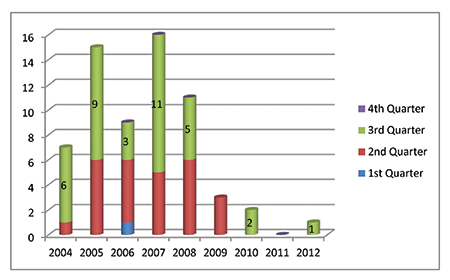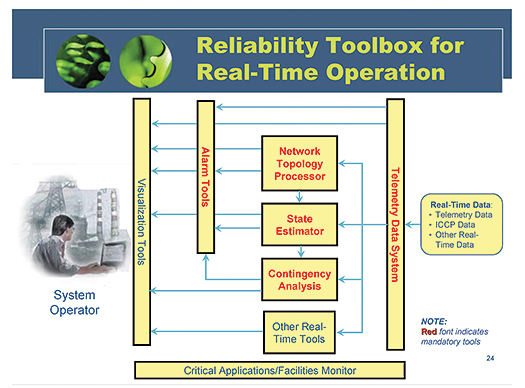On August 14, 2003, approximately 50 million people throughout the Midwest and Northeast United States and Ontario, Canada, experienced an electric power blackout. In the aftermath of the Great Northeast Blackout, the industry has been busy addressing the recommendations from the Blackout report released in April of 2004.
Several recommendations, related to institutional issues, have already been implemented. These include establishment of the Electric Reliability Organization (ERO) starting July 2006, with the North American Reliability Corporation (NERC) fulfilling the ERO role. Beginning June 2007, mandatory and enforceable compliance by the industry with reliability standards was instituted, along with penalties as well as requirement to fix the violations. Also, the Federal Energy Regulatory Commission (FERC) and NERC reviewed the reliability standards of that time, identified deficiencies, and have continued to revise, largely with the help of industry’s practitioners and subject matter experts, these standards to address the deficiencies. Additionally, the role of Regional Transmission Organizations (RTOs), Independent System Operators (ISOs) and other reliability entities in maintaining bulk power system reliability has been clarified. These efforts have improved the industry’s understanding of roles and obligations in maintaining reliable operation of the interconnected network, a lack of which contributed to the Blackout. A few of the specific recommendation areas are worth noting.
Vegetation Management
One of the causes of the Blackout was failure ‘to manage adequately tree growth in transmission rights-of-way.’ Significant progress has been made in addressing the tree growth issue as NERC has developed, and enforced since 6/18/2007, vegetation management standards (FAC-003-1). The following figure from a NERC report shows vegetation related transmission outages reported to NERC under Category 1 (Grow-ins: Outages caused by vegetation growing into lines from vegetation inside and/or outside of the ROW). A downward trend in these outages can be seen during recent years.

Grow-In Outages Caused by Vegetation Growing Into Lines From Inside and/or Outside the ROW Courtesy – NERC
Situational Awareness
Inadequate situational awareness was identified as one of the Blackout causes. Situational awareness refers to ensuring that accurate, dependable, timely and comprehensive information on current system conditions is continuously available to operators. This includes information on the current state of bulk electric system as well as on the potential impact of contingencies, and of changing generation, load and power transfer scenarios.
Situational awareness became a popular industry term following the Blackout. The industry immediately started to develop novel situational awareness tools. Operators started installing in their control centers large, state-of-the-art, high-definition visualization screens to display information from their own as well as from neighboring systems. Research on human performance aspects was conducted to design screens for optimum human comprehension. For example, in 2008, the Electric Power Research Institute (EPRI) investigated the state of situation awareness in the power systems industry by examining the use of color, automation and predictive tools to support the highest levels of situation awareness, with the goal to identify design guidelines for situational awareness tools for power systems operations. Even today, finding ways, tools and innovative technology solutions to improve situational awareness remains a major goal for operators, energy management system (EMS) vendors and research community.
Synchrophasor Technology
Synchrophasor technology has demonstrated the potential to enhance situational awareness by providing high-resolution – 10 to 60 samples per second – view across a wide area of the power system, along with GPS-synchronized time stamping. Synchrophasor technology has been often referred to as an MRI of power system, as opposed to an X-ray provided by the SCADA technology. Tools have been developed to display synchrophasor data in real time, in order to provide an instantaneous view of power system quantities to operators. The quantities include transmission voltages, line currents and MW/MVAR flows, bus frequency and phase angles. When key quantities are monitored at important locations, the information can measure power system stress and foretell an impending system emergency.
Synchrophasors are measured using devices called phasor measurement units (PMUs), which are typically installed at transmission stations. At the time of the Blackout, there were about 50 phasor measurement units connected to the U.S. grid. Today, over 1000 phasor measurement units are nearing final installation; this is a direct result of the Smart Grid Investment Grant funding and the continued leadership of the U. S. Department of Energy. The primary venue for the advancement of this technology has been the North American Synchrophasor Initiative (NASPI), which has brought together industry segments such as utilities, vendors, researchers and academics. With the near completion of the new synchrophasor infrastructure, the industry focus will now be shifting towards applications to capitalize on this new infrastructure. Many prototype applications have already been demonstrated as the industry continues to explore the use of synchrophasors in real time and off-line environments. An industry R&D effort is underway among the research community, end users (grid operators and planners) and EMS vendors to produce production-grade synchrophasors applications.
In recent years, transmission operators have expressed keen interest in having asset/equipment condition/health information available in control centers to improve their situational awareness and to facilitate their decision-making. With aging assets, concerns about critical equipment experiencing failures have increased. Equipment condition information can provide the operator with ‘look ahead’ capability to proactively plan ahead for potential security or emergency situations. Equipment information facilitates operator’s decision making and operational risk management abilities. Equipment health diagnosis technologies, also known as sensor technologies, have made tremendous progress in recent years and it makes practical sense to utilize the emerging technologies for the benefit of grid operations where practicable and cost effective. Utilities are forming asset health centers, with the primary focus to provide venue for asset managers to be able to pursue prudent life-cycle management practices, and with secondary goal to provide pertinent asset information to the operators after that information has been vetted by asset managers.
Another cause for the Blackout was identified as inadequate system understanding, specifically referring to failures to maintain adequate reactive power support and to ensure operation within secure limits. Recommendations to address this cause included adopting better real-time tools, strengthening reactive power and voltage control practices, reevaluating system planning and operating criteria, and improving quality of system modeling data and data exchange practices. To address these recommendations, the utilities, RTOs/ ISOs, NERC, vendors and researchers have spent considerable efforts in enhancing reliability standards and criteria, study tools and techniques, and in implementing revised tools and operating procedures. A few examples of these efforts are summarized below.
Real Time Tools for Analysis and Control
In the summer of 2004, NERC formed the Real-Time Tools Best Practices Task Force (RTBPTF), made up of industry subject matter experts, to identify the best practices for real-time reliability tools used to build and maintain real-time network models, perform state estimation and contingency analysis, and maintain situational awareness in accordance with NERC Reliability Standards. The task force was also instructed to develop guidelines for minimally acceptable capabilities for these critical reliability tools and to recommend specific requirements to be included in reliability standards for these tools. The task force recommended five mandatory tools that should be viewed as core elements of an operator’s ‘reliability toolbox,’ as shown in the figure below. With this guidance, many reliability entities have implemented these tools in their control centers.

Reliability Toolbox
Source: NERC RTBPTF Final Report, March 13, 2008
System Performance Assessment and Criteria
In 2004, FERC formed an interoffice staff team to develop the principles for efficient and reliable reactive power supply and consumption. On February 4, 2005, FERC issued the staff report, which contains a series of technical and market issues related to reactive power.
On March 8, 2005, FERC held a technical conference to address specific issues raised in the staff report. This effort by FERC and the utility industry provided a good foundation to address the adequacy of reactive power support for real time operations. Also, NERC revised and started enforcement of its Voltage and Reactive (VAR) reliability standards in 2011.
To understand system limitations for ensuring secure operation, operators and planners need to perform simulation studies to assess system performance under contingency conditions and compare the performance with performance criteria documented in NERC transmission planning (TPL) standards. NERC, with help from industry experts, initiated efforts to revise the transmission planning (TPL) standards in 2007. A phased enforcement of the revised TPL standards began in May 2009 and is still in progress. The industry continues to make progress in implementing simulation study procedures that call for maintaining adequate reactive power support and ensuring operation within secure limits. This includes studies in various timeframes, including long-term (one year or more), short-term (seasonal, within a year) and real-time. While a vast majority of real-time contingency analysis studies are performed to assess steady-state performance using power flow methods, selected reliability entities, such as PJM and CAISO, are making efforts to implement time-domain simulation capabilities to assess dynamic performance in real-time under contingency conditions.
The scope of modeling used for these studies is also an important aspect, which is a topic of considerable debate among, and interest to, the operators and planners. Reliability entities are utilizing resources to make sure the geographic scope of model used in real-time studies and the associated modeling data are adequate to simulate the system performance phenomena of interest.
Summary
A focus that has been emphasized after almost every important blackout event around the world has been the concept of the three T’s – trees, tools, and training – as a key in being better prepared to minimize the impact of future events. We have discussed trees and tools. Training on all aspects of the issues described here is obviously critical and NERC-approved certification has become mandatory for operations staff of reliability entities.
In the aftermath of the 2003 Blackout, much has been done by the industry to enable it to improve planning, design, and management of the grid to reduce the likelihood of large cascading outage events. While the industry has come a long way, more still needs to be accomplished. As evident from the September 2011 Arizona-Southern California event, the industry still needs to be vigilant and proactive in securing necessary tools to assess and understand system limitations. The industry could seek, develop and implement new and innovative technologies to stay ahead of new challenges such as cyber security, environmental policies, changing generation mix and aging assets.
The grid continues to evolve and as it does, system operators are faced with new challenges and threats to the system. As more information and communication technologies are added to the grid infrastructure, cyber security will be a growing issue. The industry is focused on this today, but it is in its infancy in terms of understanding what will be the best ways to deal with the challenges information and communication technologies bring. Integrating renewable generation resources such as wind and solar brings a different set of challenges due to their variable nature and that wind resources, because of their remote locations, will require new transmission infrastructure. The industry is quickly learning more about how to best integrate and manage these resources, but it will be an evolving process.
As in the case of the 2003 Blackout, the industry has a history of responding effectively to its biggest challenges. Outages will always be a fact of life, but the more that is learned and the more prepared the industry becomes, the greater the chance that outages affecting tens of millions of people for long periods of time will become a thing of the past.
About the authors
 Navin Bhatt is a Technical Executive with the Electric Power Research Institute (EPRI) where his activities focus on R&D in the smart transmission grid, and transmission operations & planning areas. Before joining EPRI, Dr. Bhatt worked at American Electric Power (AEP) for 33 years, where he conducted, managed and directed activities related to advanced analytical studies; managed AEP’s transmission R&D program; participated in the development of NERC standards; and participated in Eastern Interconnection Phasor Project (EIPP) and North American Synchrophasor Initiative (NASPI) activities. Dr. Bhatt received a BSEE degree from India, and MSEE and PhD degrees in electric power engineering from the West Virginia University.
Navin Bhatt is a Technical Executive with the Electric Power Research Institute (EPRI) where his activities focus on R&D in the smart transmission grid, and transmission operations & planning areas. Before joining EPRI, Dr. Bhatt worked at American Electric Power (AEP) for 33 years, where he conducted, managed and directed activities related to advanced analytical studies; managed AEP’s transmission R&D program; participated in the development of NERC standards; and participated in Eastern Interconnection Phasor Project (EIPP) and North American Synchrophasor Initiative (NASPI) activities. Dr. Bhatt received a BSEE degree from India, and MSEE and PhD degrees in electric power engineering from the West Virginia University.
Dr. Bhatt is a Fellow of IEEE. He is a licensed Professional Engineer in Ohio. He has authored over 40 technical papers. Dr. Bhatt was a member of the NERC technical team that investigated the August 14, 2003 blackout on behalf of the US and Canadian governments. He was a co-author of an IEEE working group paper that received in 2009 an award as an Outstanding Technical Paper. Dr. Bhatt has chaired 3 NERC teams and 2 EIPP/NASPI task teams.
 Paul Myrda is a Technical Executive with the Electric Power Research Institute working in the Power Delivery and Utilization Sector. Currently he is program manager for the Information and Communications Technology for Transmission. In this role Paul facilitates activities across the EPRI organization related to transmission Smart Grid. Paul is also involved in cyber security activities as an External Advisory Board (EAB) member of the Trustworthy Cyber Infrastructure for the Power Grid (TCIPG) Center. Paul represents EPRI on the Industrial Advisory Board for the Power Systems Engineering and Research Consortium and the Center for Ultra-Wide-Area Resilient Electric Energy Transmission Networks (CURENT).
Paul Myrda is a Technical Executive with the Electric Power Research Institute working in the Power Delivery and Utilization Sector. Currently he is program manager for the Information and Communications Technology for Transmission. In this role Paul facilitates activities across the EPRI organization related to transmission Smart Grid. Paul is also involved in cyber security activities as an External Advisory Board (EAB) member of the Trustworthy Cyber Infrastructure for the Power Grid (TCIPG) Center. Paul represents EPRI on the Industrial Advisory Board for the Power Systems Engineering and Research Consortium and the Center for Ultra-Wide-Area Resilient Electric Energy Transmission Networks (CURENT).
Previously, Paul was Director of Operations and Chief Technologist overseeing planning and asset management functions for Trans-Elect’s operating companies. He championed an innovative protection and control system upgrade project for the Michigan Electric Transmission Company an affiliate of Trans-Elect. This project fully leveraged the capability of IEC 61850, physical security, telecommunications and data warehousing technologies using EPRI’s Common Information Model.
Paul has over 35 years of experience including leading edge technology implementations. His diverse background includes planning, engineering, information systems and project management. He has an MBA from Kellogg (2000) and MSEE and BSEE from Illinois Institute of Technology (1980 and 1977, respectively). He is a licensed professional engineer in Illinois, member of CIGRE and Senior Member of the IEEE.







